SCRUM is one of several leading approaches to project management within the AGILE methodology.
The Scrum Guide defines SCRUM as a lightweight framework that allows teams and organizations to create value by applying adaptive solutions to complex problems.
If the above definition of SCRUM sounds too abstract, vague, and theoretical for you, it won't seem so anymore after reading this article.
We will translate it into much clearer and more concrete language.
In the following article, we will closely examine the theory and philosophy behind SCRUM.
We will focus on the values that allow SCRUM teams to achieve and realize their goals.
We'll also briefly discuss the basic differences between AGILE and SCRUM.
We should immediately emphasize that SCRUM and AGILE are not synonyms but related concepts. In what way? We'll talk about that in a moment.
If you are curious about the methods used in project management that are most relevant to current market conditions, then please read the following article.
It's worth it!
What is Agile Project Management?
You probably have heard about terms, concepts such as SCRUM methodology, product backlog, Sprint backlog, product owner, Sprint review, the definition of done, project manager, operating framework, end of Sprint, daily SCRUM, daily meeting SCRUM, and SCRUM retrospective.
They are very popular with developers, project managers, UX designers, and specialists.
They are part of industry jargon and everyday communication in software development companies and UX agencies.
However, the story of SCRUM should start not by explaining its vocabulary but by answering the question – What is Agile Project Management (AGILE)?
AGILE is a broad term in which SCRUM is included. It isn't a counterproposal; it isn't synonymous with it; it isn't a competitor. So what is SCRUM?
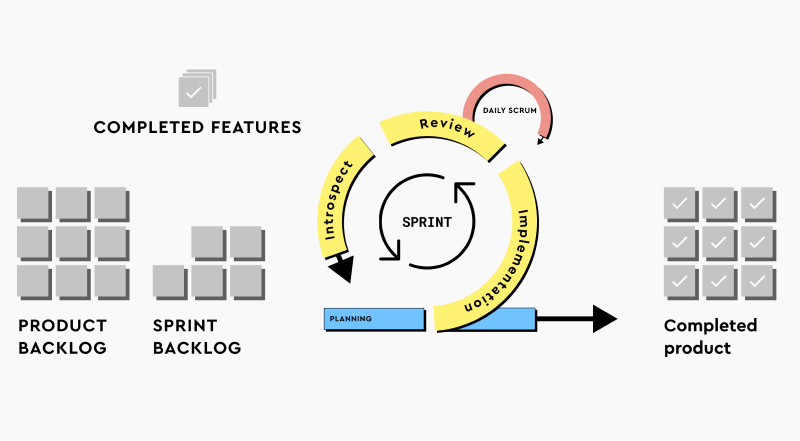
The SCRUM agile methodology is, along with Kanban, Feature Driven Development (FDD), Extreme Programming (XP), Lean Software Development (LSD), Adaptive System Development (ASD), Dynamic Systems Development Method (DSDM), Crystal Clear among the approaches that can be distinguished in AGILE.
According to data presented in the article "Adopting Agile: The Latest Reports About The Popular Mindset," as many as 56% of development teams report using SCRUM methodology in their projects.
Are AGILE and SCRUM a trend? Yes, but there are good reasons for it. Reasons supported by results – measured in numbers and percentages but also backed by subjective evaluations, which, after all, also matter.
AGILE is a methodology that relies on a continuous, ongoing iteration of software lifecycle processes.
The AGILE methodology aims to deliver solutions (e.g., specific functionalities) in short, maximum-value cycles.
In practice, the idea is to build software (e.g., a web or mobile application) in a flexible way, following the principle of small steps, small successes.
This enables software development to be more relevant to the rapidly changing market, business, and technological context.
Instead of thinking about big effects and changes, AGILE proposes thinking in terms of smaller tasks that can be done continuously in a specific – usually much shorter – time.
Tasks that lead to a specific value, for example, the implementation or improvement of a particular functionality.
That makes it possible to manage the project flexibly. This method also allows you to change priorities and react faster to arising problems.
AGILE allows you to manage projects more efficiently; it is its most important characteristic.
It provides significant budget and time savings. It also makes work much more efficient.
AGILE, SCRUM, in a way, also allow you to deal with the problem of so-called "work-in-progress."
Work-in-progress is a term that refers to work that is simultaneously necessary for the production of the final product but, at a given point in the product's development, doesn't carry a specific value. And it could be, for example, a particular functionality.
A customer who chooses to develop software in the AGILE methodology receives specific solutions (values) at fixed intervals.
They will also be able to react to them.
AGILE Manifesto
AGILE is based on four values and twelve principles laid out in the famous AGILE Manifesto.
Without going into the – shrouded in legend and already somewhat mythologized – history of the manifesto's creation, let's say that the four values mentioned are:
- prioritizing people and the interactions taking place between them over processes and tools
- prioritizing working software over documentation
- prioritizing reaction to change over sticking to the plan
- prioritizing cooperation with a customer over negotiating a contract.
Agile's 12-point manifesto focuses on:
- satisfying customers and offering valuable software
- changes that lead to competitive advantages
- frequency of delivery of working software
- daily collaboration between developers and stakeholders
- motivating employees, creating an optimal work environment for them
- effectiveness of face-to-face communication
- evaluations of delivered, working software
- sustainability of development, maintaining a steady pace of changes
- on project/software quality
- simplicity, streamlining the method of working
- self-organization of teams
- continuously improving productivity, quality, and efficiency.
There are indeed many benefits of using the AGILE methodology, hence its popularity, which far exceeds the domain of IT, software development, and web and mobile application development.
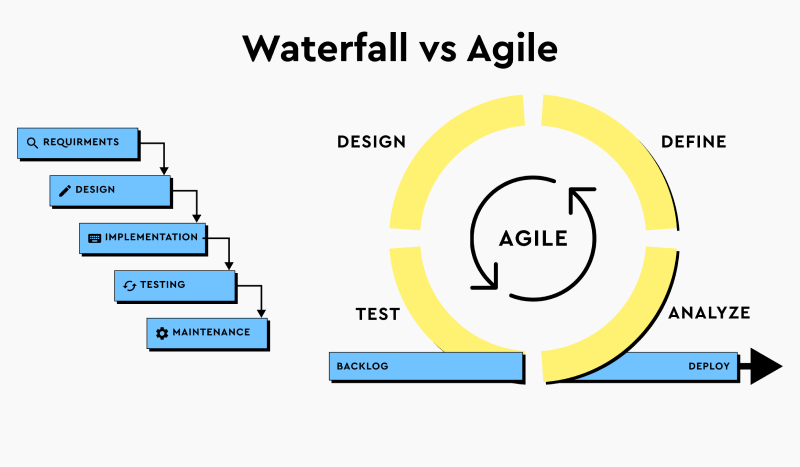
According to the study "AGILE i SCRUM. Charakterystyka środowiska w Polsce" (AGILE and SCRUM. Characteristics of the environment in Poland) prepared by the AGILE Poland portal, AGILE is the methodology most widely used in the following industries:
- IT
- consulting
- banking
- finance and accounting
- insurance
- and telecommunications.
AGILE is recommended for projects where there are areas of uncertainty and where only some things can be defined, specified, and quantified before work is undertaken.
AGILE will prove especially useful when developing software for industries where changes are:
- frequent
- regular
- unpredictable
- significant in terms of business, organization, or any other aspect.
The AGILE methodology is much more open-ended and less dependent on a rigid, concretized, and detailed plan.
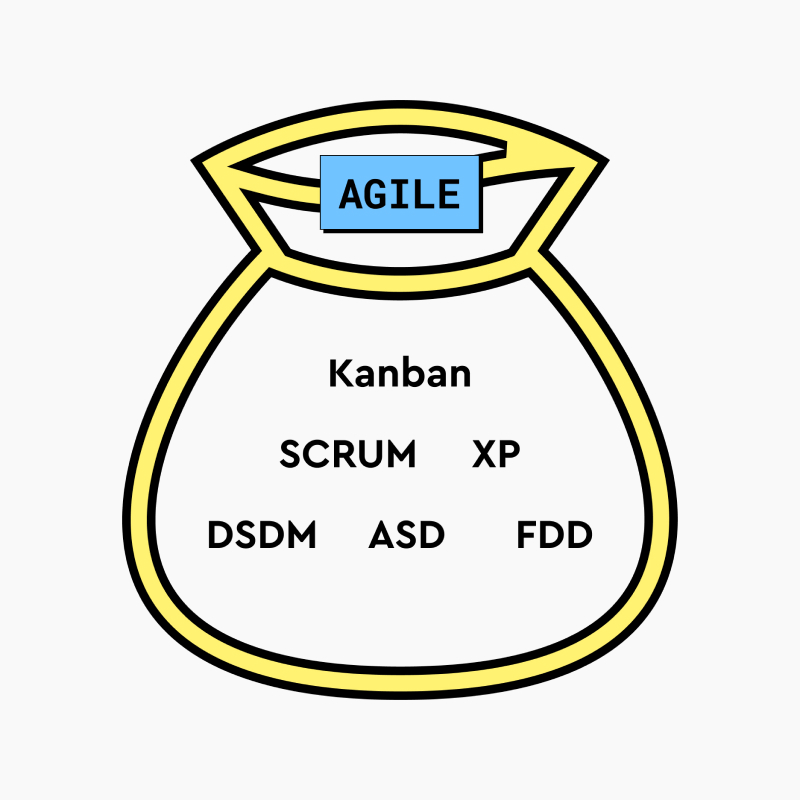
It is based on changing requirements and a continuous process of feedback from stakeholders and end users.
Each iteration aims to produce a working product, which is intended to meet needs better, more adequately, and achieve goals more effectively.
The goal of business stakeholders and developers is to work closely together to produce software that better fits customers' needs and goals (short- and long-term for a company).
In practice, when running projects in an agile methodology, programming (development) and testing work is carried out parallelly.
AGILE is used to obtain and respond to feedback more effectively.
What is Scrum methodology?
SCRUM is an AGILE methodology that aims to create new products in an environment prone to change.

It's one of the most popular AGILE frameworks that is used to produce and develop complex software.
SCRUM is based on the following:
- Transparency – guarantees full and unrestricted access to information.
- Adaptation – enables changing priorities
- Inspection – improves product and process.
SCRUM focuses on:
- interactions and relationships
- synergy – obtaining the effect of collective intelligence
- empiricism – decisions are made based on experience and observation
- lean thinking – supports the economization of operations, efficiency
- an incremental, evolutionary approach to software optimization.
Its most elementary unit is the SCRUM team, which consists of a single SCRUM Master, Product Owner, and developers.
In terms of structure and hierarchy, it is a flat, multifunctional, internally managed system.
Team members independently determine the scope of work, duties, responsibilities, and the time they will spend on a given activity.
The size and method of organization in a team are not accidental. It helps maintain higher agility, better communication, and productivity.
It is also worth remembering that SCRUM is a set of roles, responsibilities, and meetings that provide a fixed structure to the software development process.
The team is responsible for all product-related activities.
What is a SCRUM Sprint?
Each SCRUM team consists of three roles:
- SCRUM Master
- Product Owner
- SCRUM Team.
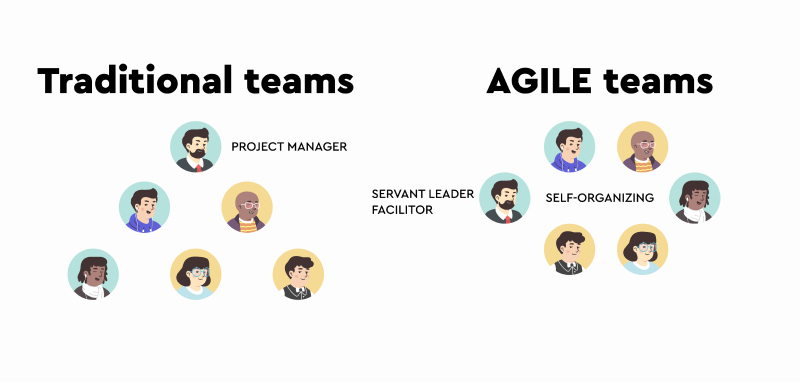
What does a SCRUM Master do?
Generally speaking, the SCRUM Master is responsible for the smooth and seamless flow of the Sprint.
Their task is to:
- remove obstacles
- organize meetings
- prepare a Sprint Product Backlog
- maintain standards defined in the SCRUM Guide
- support the self-management of team members
- support the creation of increments that meet the Definition of Done
- support productivity, also by defining Product Objectives
- educate the organization on how to implement SCRUM.
The Product Owner's role is to:
- create and communicate the product vision
- ensure that all requirements are met, such as business, functional, and market
- manage the backlog
- motivate the team (the Product Owner is not the person in charge of the project, so they don't and shouldn't have real power over the team members)
- formulate and communicate what the Purpose of the Product is
- create and communicate the elements of the Product Backlog
- make the Product Backlog transparent, visible, and understandable.
The SCRUM Team (in which traditional Scrum roles, functions are blurred) is responsible for:
- product development
- product testing
- creating a plan for a Sprint
- following the Definition of Done.
SCRUM project management is mainly based on the work of the team within Sprint and Sprint planning.
To put it simply – the core of SCRUM are Sprints, which usually don't last more than one month.
Sprints follow each other and are simply cycles in which we deliver working software. They are based on increments and are connected to previously completed work.
It is extremely important that during a Sprint, the team cannot make changes that detract from the Sprint Goal.
What are the advantages and disadvantages of SCRUM?
Thanks to designated roles, rules, and clear structures, SCRUM provides:
- better project transparency
- better project visibility
- better flow of information and better understanding and communication between team members
- the ability to predict problems
- greater scope and depth of team responsibility
- the desired autonomy, independence, and self-reliance of the team
- greater flexibility
- a more profound awareness of goals thanks to continuous feedback
- faster response to new information, data, results, or observations
- greater effectiveness and efficiency of work
- the ability to detect and repair errors faster.
SCRUM, while highly praised, is not without its flaws.
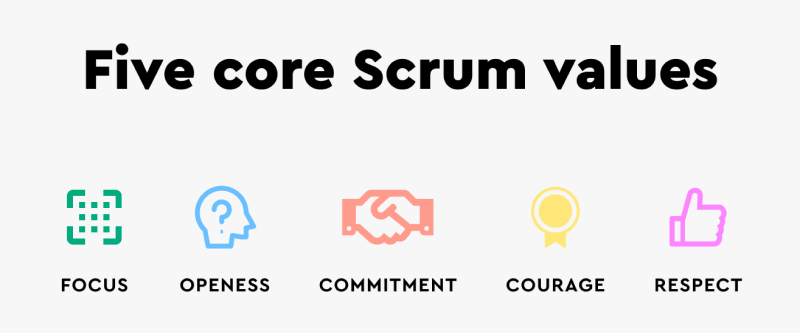
Usually, people emphasize the fact that it requires:
a significant level of experience
a lot of commitment and self-discipline from the team.
Moreover, SCRUM is sometimes criticized for:
- increasing the risk of expanding the scope of a project
- increasing the risk of adding features continuously
- the high responsibility of the SCRUM Master, who must have specific personality/character traits to realize the goals and the Scrum values incorporated in this method
- increasing budgetary risks, raising project costs if tasks are defined incorrectly.
What is SCRUM? Summary
- Although eagerly compared and used as interchangeable terms, SCRUM and AGILE are not the same.
- AGILE is a broad term in which SCRUM is included.
- AGILE is a commonly used methodology in the IT, consulting, banking, finance and accounting, insurance, and telecommunications industries.
- AGILE is a methodology that relies on a continuous, ongoing iteration of software lifecycle processes (e.g., its development or testing).
- The AGILE methodology aims to deliver solutions (e.g., specific functionalities) in short, maximum-value cycles.
- Instead of thinking about big effects and changes, AGILE proposes thinking in terms of smaller tasks that can be done continuously in a specific – usually much shorter – time.
- AGILE provides a flexible way to manage a project. It also makes it possible to change priorities and respond to problems more quickly.
- AGILE is recommended for projects where there are areas of uncertainty and where only some things can be defined, specified, and quantified before work is undertaken.
- AGILE will prove especially useful when developing software for industries where changes are frequent, regular, unpredictable, and significant in terms of business, organization, or any other aspect.
- It is based on changing requirements and a continuous process of feedback from stakeholders and end users.
- Each iteration aims to produce a working product, which is intended to meet needs better, more adequately, and achieve goals more effectively.
- SCRUM is one of several leading approaches within the AGILE methodology.
- SCRUM is a lightweight framework that allows teams and organizations to create value by applying adaptive solutions to complex problems.
- The SCRUM methodology is, along with Kanban, Feature Driven Development (FDD), Extreme Programming (XP), and several others, one of the approaches that can be distinguished in AGILE.
- SCRUM is an AGILE methodology that aims to create products in an environment prone to change.
- SCRUM is one of the most popular AGILE frameworks that is used to produce and develop complex software.
- Among other things, SCRUM is built on the principles of Transparency and Inspection.
- The most elementary unit of SCRUM is the SCRUM team, which consists of a single SCRUM Master, Product Owner, and developers.
- In terms of structure and hierarchy, it is a flat, multifunctional, internally managed system.
- Team members independently determine the scope of work, duties, responsibilities, and the time they will spend on a given activity.
- SCRUM is a set of roles, responsibilities, and meetings that provide a fixed structure to the software development process. The team is responsible for all product-related activities.
- The core of SCRUM are Sprints, which usually don't last more than one month. Sprints follow each other and are simply cycles in which we deliver working software.
- Sprints are based on increments and are connected to previously completed work.
- During a single Sprint, we cannot make changes (proper Sprint Planning is important, Sprint Retrospective) that detract from the Sprint Goal.
- Thanks to designated roles, rules, and clear structures, SCRUM provides better project transparency, visibility, information flow, understanding, and communication between team members.
- SCRUM provides the ability to predict problems, increase the scope and depth of team responsibility, and the desired autonomy, independence, and self-reliance of SCRUM teams.
- SCRUM is sometimes criticized for increasing the risk of expanding the scope of a project and increasing the risk of constantly adding features.
- The SCRUM Master – as a role, a function – is also sometimes criticized for having too much responsibility to bear.
- To become a SCRUM Master, a person needs to have specific personality/character traits to realize the goals and values incorporated in this method.
- AGILE, SCRUM, in a way, also allow you to deal with the problem of so-called "work-in-progress."
- Work-in-progress is a term that refers to work that is simultaneously necessary for the production of the final product but, at a given point in the product's development, doesn't carry a specific value.





